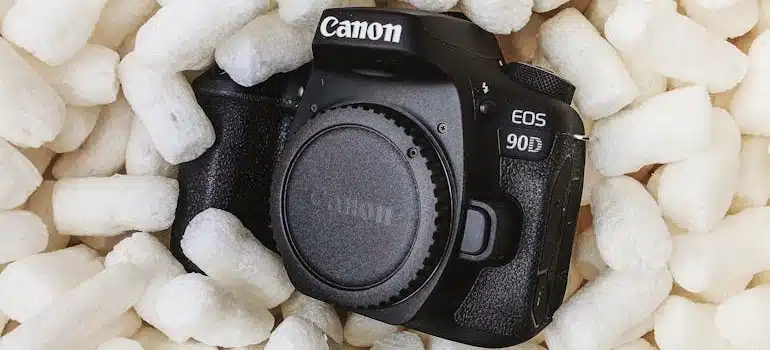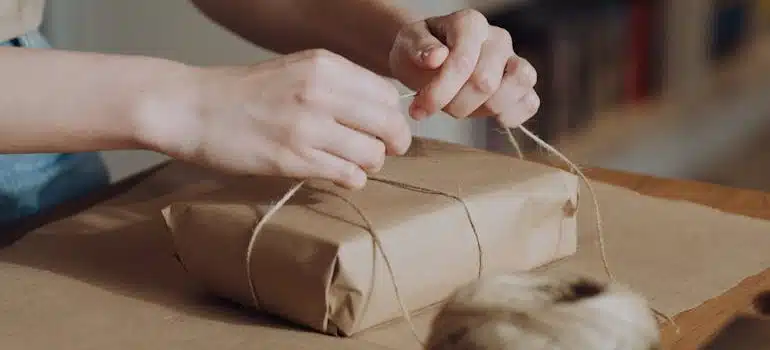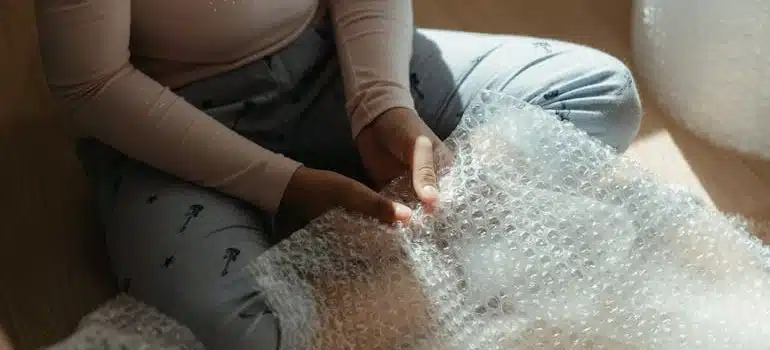Creative ways to reuse packing materials
Packing materials build up quickly after a move or a large delivery. You might feel tempted to toss them. However, reusing those materials can save money and reduce waste. Cardboard boxes, bubble wrap, packing peanuts, and paper all have more life in them. Using creative ways to reuse packing materials also supports sustainability. Instead of buying new supplies, work with what’s already available. Our Pro Movers Miami article below offers simple ideas to get started!
Why it matters to reuse packing material after moving
Reusing packing supplies and materials helps reduce clutter, saves resources, and keeps more items out of landfills. Moving often creates extra waste, especially if you’re unpacking on a deadline. But throwing out materials that still have value just adds to the environmental burden.
You can turn cardboard, paper, and plastic into tools for organizing, cleaning, or even decorating. Repurposing what you already have also cuts down on unnecessary spending. If you’re planning another move later, keeping your materials now saves you time and effort then.
Being thoughtful about what stays and what goes can support both sustainability and convenience. When you reuse packaging materials at home, you keep useful supplies close by and give them a new role with minimal effort.

Ways to reuse cardboard boxes
After unpacking, you’re often left with stacks of cardboard boxes in good shape. Instead of breaking them down right away, consider how they could serve you again. You can use them across the home, in the garage, or even in the garden.
Storage
Use cardboard boxes to organize seasonal clothes, decorations, or tools. Place smaller boxes inside drawers or cabinets to create makeshift compartments. Label the outside with a marker to keep things easy to find. If you stack them on shelves, reinforce the bottoms with extra tape to prevent sagging.
Boxes also work well for toy bins, pantry storage, or packing garage supplies. Even temporary storage becomes easier when you reuse cardboard boxes that are already shaped and sized for common household needs.
Gardening
Place flattened boxes under mulch to block weeds in flower beds. The cardboard smothers grass and breaks down over time, improving soil health. Add strips to your compost pile as a brown layer that balances out food scraps.
For container gardens, cut cardboard to fit under pots to protect patios from water stains. Some people also use boxes as seedling trays or temporary covers for delicate plants in colder weather.
DIY projects
Cardboard makes a solid base for drawer dividers, paper sorters, or homemade magazine holders. You can shape and tape pieces into desktop organizers or use them to back framed artwork.
If you want a quick fix, stack two or three layers to create a sturdy platform for lightweight items. Even pet owners can benefit when they reuse packing materials. Turn a medium box into a cozy cat bed or rabbit hideaway with just a blanket and a cut-out door.
Shipping or gifting
Save clean, undamaged boxes for future deliveries or storage swaps. You can reuse them when mailing packages or giving gifts. Add wrapping paper or paint for a more personal touch. Tuck away smaller boxes in a closet so you always have packaging when needed.
Kids’ crafts and play
Boxes can turn into cars, houses, robots, or costumes with just a few cuts and tape. Reusing cardboard for crafts lets kids create without spending extra on supplies. Let them decorate with crayons, markers, or stickers and build play structures that support imagination.
You can also cut up flat panels for puzzle boards or coloring sheets. Smaller boxes work well for storing board game pieces or creating custom game boards. And if the box is too large to store, break it down and save the panels for future craft days.
Ideas for bubble wrap reuse
Bubble wrap isn’t single-use. You can reuse it for insulation, storage, or travel prep. Keep sheets rolled or folded to make them easier to store and reuse later.
Insulate windows and outdoor containers
Tape bubble wrap to windows during colder months to help block out drafts. Use water to lightly stick the wrap to the glass, or secure it with painter’s tape. Gardeners can also wrap pots to shield roots from sudden frost. Bubble wrap creates a barrier that slows down heat loss.
Add padding inside the suitcases
Before your next trip, use bubble wrap around anything that might leak or break. Wrap bottles, jars, or chargers and place them between layers of clothing. This protects your belongings without adding extra bulk or needing travel-specific containers.
Line drawers, boxes, or cases
Cut bubble wrap to fit inside kitchen drawers, toolboxes, or craft bins. This way to reuse packing materials cushions tools, utensils, or electronics, and keeps them from shifting. If you move again, leave the wrap in place and pack right on top.
Keep a small piece at your desk
Use leftover wrap as a quick stress outlet during work. Popping bubbles helps break mental tension and gives your hands something to do during calls or breaks. It’s a fun reuse with no cost.
Wrap fragile items for long-term storage
Use bubble wrap to protect stored breakables you aren’t using daily. Dishes, glass décor, or electronics stay safer when cushioned with reused wrap. Line both the bottom and top of boxes for full coverage. Secure wrapped items with rubber bands to avoid using more tape.

How to repurpose packing peanuts
Packing peanuts may seem like trash, but they’re one of the most reusable moving materials. As long as you keep them clean and dry, they can serve multiple purposes in shipping, gardening, crafting, or pet care. Store them in a sealed container to prevent moisture damage, especially if they’re biodegradable. Below are several practical ways to reuse and upcycle packing peanuts at home.
Reuse in shipping boxes
Packing peanuts offer excellent protection when you need to ship fragile items. Pour a layer into the bottom of the box, then place your item in the center. Fill the surrounding space, so the item stays in place during transit. Before sealing the box, gently shake it to check for movement. This method works well for electronics, glassware, or ceramics.
Improve drainage in garden containers
Large pots often need better drainage, especially for indoor plants. Reuse packing materials and add a few inches of peanuts to the bottom of the planting container. Cover them with mesh or landscape fabric before adding soil. The peanuts reduce the amount of dirt needed and keep the pot lighter. This makes plants easier to move and prevents root rot from water buildup.
Use in homemade craft projects
Clean packing peanuts can be cut, shaped, or glued into DIY projects. Fill beanbags or decorative pillows by combining peanuts with fabric scraps. They also work as fillers in draft stoppers placed near doors. If you enjoy seasonal crafts, use peanuts to build 3D models, snowmen, or lightweight ornaments. Store extras with your art supplies for quick use.
Pad pet carriers or soft crates
Some pets feel more secure with soft padding inside their carriers. Create a buffer by placing a thin towel over a small layer of peanuts at the base. It helps reduce vibration and shock during car rides or appointments. Only use this method for pets that don’t chew or dig, since peanuts should not be ingested. Always check for signs of damage before reusing.
Store for seasonal packing
Packing peanuts are perfect for protecting holiday decorations or delicate keepsakes. Fill gaps in boxes holding candles, ornaments, or figurines. The peanuts prevent movement during storage and reduce the risk of breakage. Keep a separate bin labeled “fragile storage fill” so you can access it easily every year.
Creative uses for packing paper
Packing paper is one of the easiest materials to reuse. It’s flexible, tear-resistant, and clean enough for multiple tasks around the house. Whether you need to protect items, wrap gifts, or create art, packing paper offers reliable support. Below are several practical and creative uses to try.
Use as custom gift wrap
Plain packing paper makes a neutral gift wrap you can customize for any occasion. Decorate it with markers, stamps, or stickers to match the event. Add a string or bow for a simple, polished look. This works especially well for birthdays, holidays, and casual gift-giving. You save money and reduce waste at the same time.
Line drawers or cabinets
Cut sheets of packing paper to match the bottoms of drawers or shelves. It creates a barrier that protects surfaces from spills, scratches, or crumbs. You can use it in kitchens, bathrooms, or craft rooms. When it gets dirty, just lift it out and replace it. No need for adhesive or permanent liners.
Clean windows and polish surfaces
Crumple packing paper into a loose ball and wipe down mirrors or windows. It leaves fewer streaks than regular paper towels and won’t shed lint. You can also polish chrome, shoes, or stainless steel surfaces. It’s especially helpful when you run out of microfiber cloths. Toss it when done—no extra cleaning required.
Create art or craft supplies
Packing paper works well for drawing, painting, or cutting projects. Kids can use it for collages, masks, or DIY posters. You can fold it into origami, cover books, or use it for paper-mâché. Teachers and child care centers often welcome donations of clean paper for craft bins. Store extra sheets rolled or flat in a labeled drawer.
Shred for pet bedding or litter liners
Tear or shred packing paper for use in small animal cages or under litter boxes. It absorbs moisture and makes a soft surface for pets like guinea pigs or rabbits. Place a few layers under bedding or inside carriers during short trips. Replace when damp or dirty, just like with store-bought liners.

Plastic wrap and shrink wrap ideas
Plastic wrap and shrink wrap often get tossed after a move, but they remain useful. When kept clean and stored in rolls or bags, they can help with bundling, sealing, and short-term protection. You don’t need much to make these flexible wraps work in daily tasks.
Wrap tool handles and cords
Loose cords can clutter drawers and get tangled fast. Wrap them with leftover plastic to keep them tight and easy to grab. The wrap clings to itself, so you don’t need tape or rubber bands. You can also use this trick on tool handles or bundles of zip ties. Store wrapped cords in a labeled bin for faster access next time you need them.
Prevent spills during travel or storage
Wrap the tops of bottles before screwing the caps back on. This adds a leak-proof barrier when storing or traveling with soaps, cleaners, or oils. Place the sealed containers in a zip bag for double protection. This reuse trick works especially well for gym bags, travel kits, or moving boxes with toiletries. Avoiding messes saves you time and effort during cleanup.
Protect outdoor tools from moisture and rust
Metal tools are prone to rust if exposed to damp air or rain. Wrap garden tools, pliers, or screwdrivers before storing them in garages or sheds. The plastic keeps out dust and moisture while keeping sharp edges contained. For extra strength, use two layers and secure with a rubber band. You won’t need to replace rusted tools as often if they stay sealed.
Reuse for future moves
Store large shrink-wrap rolls in a closet or bin for the next move. Wrap kitchen drawers, toolboxes, or rolled blankets without needing packing tape. It’s helpful when packing and moving furniture like desks or dressers with loose compartments. Just apply pressure to stretch the wrap slightly—it clings and holds shape. Having this wrap on hand saves time when packing odd-shaped items.
Secure loose lids or drawers
If you have storage containers that pop open easily, wrap them once or twice with shrink wrap. This keeps items from spilling while you rearrange storage or move bins into closets. You can also wrap drawer units if you shift furniture between rooms. Shrink wrap keeps lightweight drawers shut without damaging the surface.
Reusable foam sheets and inserts
Foam sheets and inserts come in many packaging boxes, often cut to shape for specific items. Instead of throwing them out, save and reuse them to protect, pad, or support other belongings. Their flexibility and durability make them useful in storage, repairs, or daily routines.
Create sliders for furniture
Heavy furniture can scratch floors or get stuck while rearranging. Cut foam sheets into small squares and place them under each leg. Slide the item easily without damaging hardwood, vinyl, or tile. The foam reduces friction while offering enough grip to control movement. You won’t need to buy dedicated sliders for most home uses.
Pad pet crates or carriers
Lining a crate with foam gives your pet extra comfort during travel. Cut the foam to fit the base and place a towel on top for softness. It cushions hard plastic floors and absorbs shock from car movement. This setup works well for short trips or vet visits. Afterward, remove the foam and clean it with a damp cloth.
Line shelves or drawers
Use foam as a soft lining for kitchen, bathroom, or workshop storage. Cut it to fit each space and set items on top. It reduces noise from sliding utensils, glassware, or tools. You can also prevent scratches and dents on delicate surfaces. The foam stays in place without glue or adhesives, so it’s easy to remove and clean.
Use in home repairs or crafts
Foam sheets make good fillers or spacers in home projects. You can wedge them under furniture, frame backing, or behind wall art. Crafters also reuse packing materials like foam to make stamps, display boards, or soft padding for tools. Keep extra pieces in a labeled container so you can reuse them when a project comes up.
Protect electronics or collectibles
Foam works well as padding inside bins when packing audio equipment, cameras, electronics, or gaming gear. Cut pieces to fit around each item for stable placement. Store the padded items in dry areas to prevent movement or impact damage. This works better than towels, which compress over time. You also avoid the bulk of using full boxes within boxes.

DIY home projects using leftover materials
You can repurpose leftover packing materials to create useful tools, storage aids, and basic home solutions. Below are easy projects that require only scissors, tape, or glue.
- Drawer dividers – Cut cardboard or foam into strips and slot them to create grids for utensils, office supplies, or tools.
- Desk organizers – Stack and glue cardboard tubes (from tape rolls) to hold pens, paperclips, or USB drives.
- Shipping station bin – Use a sturdy box lined with foam to keep scissors, tape, and labels in one place.
- Padded tool tray – Cut foam inserts to hold small tools or screws securely inside drawers or toolboxes.
- Wall-mounted storage – Attach small boxes to a wall or board to hold mail, chargers, or keys.
- Framed packing paper art – Decorate plain packing paper with stamps or sketches, then frame it for simple wall decor.
- Laptop stand – Fold and tape cardboard pieces into a wedge shape to raise a laptop at an angle.
- Temporary drawer stops – Use folded bubble wrap or foam strips to stop drawers from sliding open during transport.
- Cable labels – Cut tape rolls into rings, label them, and slide them onto cords to identify devices.
All of these projects use only basic tools and can be done in under an hour. Save clean materials in a labeled bin so they’re easy to find when needed. If you move again, many of these items can also be reused in packing.
Make every packing material count
Packing materials don’t need to go to waste once the move is done. With a few simple ideas, you can reuse cardboard, plastic, paper, foam, and other items in ways that support daily life. Starting with organizing tools over lining drawers to pet bedding, small actions lead to real savings.
Keep only clean, usable materials and store them in a dry place. When something breaks, needs padding, or calls for quick organization, you’ll have the supplies ready. Ways to reuse packing materials aren’t only about cutting waste but making your space work better with what you already have.
